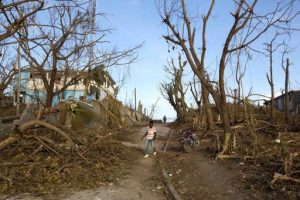The awful truth about the media coverage of Haiti, the poor Caribbean country that became the world’s first black republic in 1804, is that it is seasonal, sad and cyclical.
With dreadful regularity — hurricane season in the Caribbean officially lasts six months of the year — there are reports of a catastrophe of some sort. And as is happening now, an especially powerful storm seems able to blow all of Haiti entirely off-course. Its interim president has warned of “real famine” in three or four months. The World Health Organisation fears a cholera epidemic such as the one in 2010. Haiti’s greatest tragedy appears to be the repetitive nature of its run of bad luck.
Except that it’s not. As an American cinema critic once rather cleverly said of the horror genre, most of such films feature contingencies that arise out of poor decisions and bad luck, not just bad luck alone. So too with Haiti, where history and geography combine into an enormous challenge, but the chief affliction is lack of governance and political will.
The alarming prediction of another cholera epidemic after last week’s Hurricane Matthew is telling. It was, admittedly, the strongest storm to rip through the region in a decade but its disproportionate impact on Haiti may indicate the extent of the country’s structural problems. Hundreds are dead, and some of the more remote areas still have no communications and are unable to report their losses.
United Nations secretary general Ban Ki-moon said towns and villages have practically been wiped off the map. Crops and food reserves have been destroyed and at least 300 schools are damaged. Several hospitals have been knocked out of action when they are needed most.
The UN has launched an emergency appeal for nearly $120 million (Dh440m) in aid to cover the next three months. At least 750,000 people in the south-west of the country are judged to be at risk of death by starvation or disease in the hurricane’s aftermath.
But Haiti’s neighbour, the Dominican Republic, with whom it shares the island of Hispaniola, appears to have weathered the same storm with minimal disturbance. The toll is small, according to the Pan American Health Organisation; hospitals are functioning and health professionals are alert for an epidemic. The authorities smoothly triggered an emergency action plan, establishing a red alert for provinces bordering Haiti, evacuating thousands of people and preparing shelters for the affected. Not only did they have air force search-and-rescue teams and army-staffed boats at the ready, but the government also organised press conferences to inform and reassure the public.
But for Haiti, such administrative efficiency has long remained elusive. Its health ministry insists that it sought to prevent the outbreak of cholera by sending supplies of water purification tablets and oral rehydration serum around the country before the storm, but reports from the worst-affected areas call these claims into question.
It shouldn’t be this way considering Haiti has already suffered six years of agony from cholera. Nearly 10,000 people died of the disease after Haiti was hit by a magnitude 7.0 earthquake in 2010, so it might reasonably be expected to be better prepared.
That said, the ever-present scourge of cholera in Haiti is a good example of the terrible dovetailing of poor decisions and bad luck. The UN belatedly admitted two months ago that it was responsible for Haiti’s worst cholera outbreak in modern times. UN peacekeepers from Nepal, where cholera is endemic, brought a South Asian strain of the disease to Haiti. Faulty human waste disposal at their camp contaminated the Artibonite, the largest river in Haiti, which had remained free of cholera for 200 years even as the disease raged in the Caribbean. That was rotten luck for Haiti but the rest of the problem is its own poor decision-making.
Even before Hurricane Matthew, only one in three Haitians had access to proper latrines and fewer than three in five had access to safe water. In the rural areas, the situation is even more dire, with sanitation and safe drinking water practically non-existent.
Unicef says that one of the main killers of Haitian children under 5 is diarrhoea, a preventable and treatable disease spread through contaminated food or water, or from person-to-person as a result of poor hygiene.
These are shocking statistics for any country, let alone in the western hemisphere. Cholera was affecting 700 to 800 people per week even before the storm. Now the WHO expects it to surge because thousands of displaced people, possibly carrying the Vibrio cholerae bacterium, will move from place to place without any hope of sanitation or safe drinking water, spreading the disease even as the rainy season begins.
The only cheering thought is that the world has taken notice of Haiti’s suffering promptly. On Monday, the WHO endorsed a plan to send one million doses of the cholera vaccine to Haiti as soon as possible. That’s half the global stockpile.
But it won’t be enough to deal with the larger issue. Bad luck can’t be helped and sometimes, vaccines and international aid can provide succour. But chronic political ill health has to be addressed by Haitians themselves.


